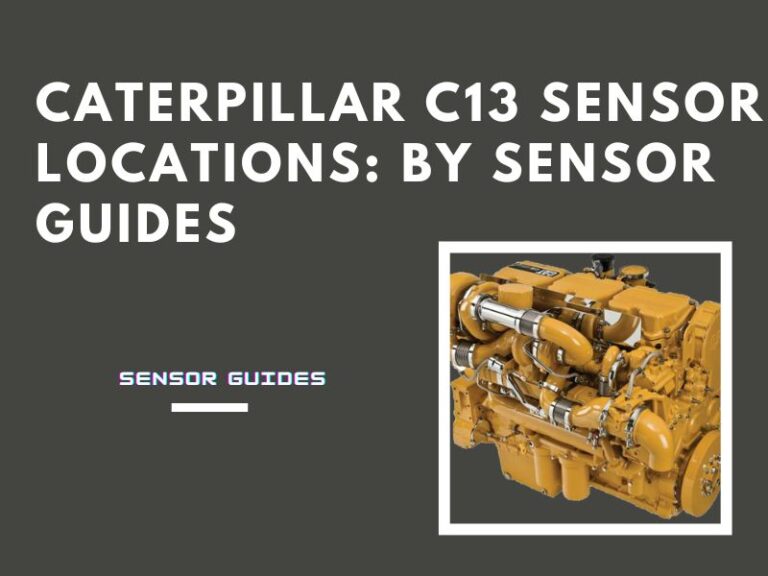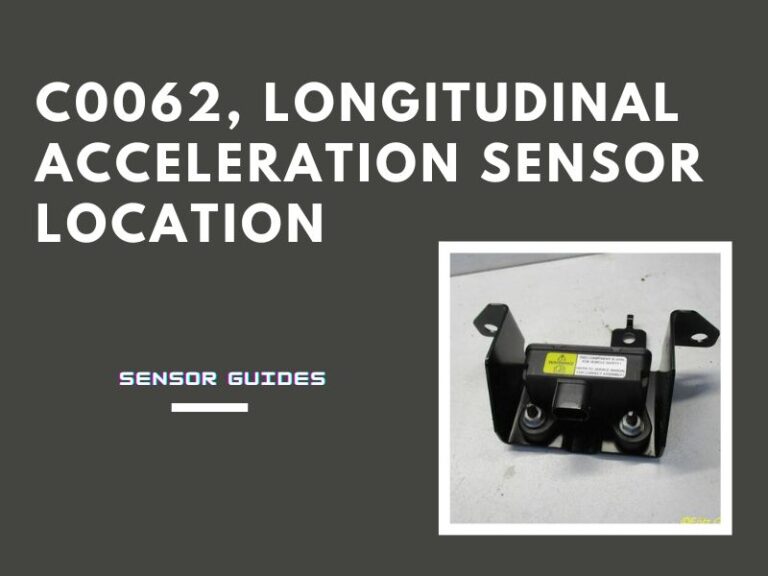4L80E Speed Sensor Location; Symptoms and Replacing Guide
In this article, we’ll explore the critical components of the 4L80E transmission speed sensors, including their locations, common symptoms of sensor issues, and a straightforward guide on how to replace them. These sensors are integral to your vehicle’s performance and safety, and understanding their functions and maintenance is essential.
Table of Contents
What does the speed sensor do on 4180E?
The speed sensors on the 4L80E transmission play a crucial role in monitoring and controlling vehicle speed and transmission function. Here’s what each speed sensor does:
Input Speed Sensor (ISS)
This sensor is located near the input shaft of the transmission. It measures the speed of the input shaft, which is connected to the engine.
The information from the ISS is sent to the Transmission Control Module (TCM), allowing it to calculate engine speed and control the shifting of the transmission accordingly. It helps ensure smooth and precise gear changes based on the engine’s RPM.
Output Speed Sensor (OSS)
Positioned on the output shaft of the transmission, near the rear of the transmission case, the OSS monitors the speed of the transmission’s output shaft. The data from this sensor is crucial for the TCM to calculate the vehicle’s speed.
This information is not only used for determining vehicle speed but also for controlling the Anti-Lock Braking System (ABS). It helps prevent wheel lockup during braking, enhancing vehicle stability and safety.
In summary, these speed sensors provide vital input to the TCM, enabling it to manage transmission shifting and ABS functions based on the speeds of the engine and the vehicle. If either sensor fails, it can lead to various symptoms, including erratic shifting and warning lights on the dashboard.
Where is the speed sensor located in the 4L80E transmission?
The 4L80E transmission has two speed sensors, the Input Speed Sensor (ISS) and the Output Speed Sensor (OSS), and they are located at different positions on the transmission:
- Input Speed Sensor (ISS): The ISS is typically located on the front of the transmission case, near the input shaft. It’s a small, threaded sensor with a connector that plugs into the transmission wiring harness.
- Output Speed Sensor (OSS): The OSS is positioned on the output shaft of the transmission, near the rear planet. Like the ISS, it is a small, threaded sensor with a connector that plugs into the transmission wiring harness.
Both of these speed sensors are essential for the proper functioning of the 4L80E transmission and its associated systems. If either sensor fails, it can lead to various issues, including transmission shifting problems and ABS-related concerns.
What are the symptoms of speed sensor on 4180E?
A malfunctioning speed sensor in a 4L80E transmission can lead to several noticeable symptoms. Here are common symptoms that may indicate an issue with one of the speed sensors (Input Speed Sensor or Output Speed Sensor) on a 4L80E transmission:
- Check Engine Light (CEL) Illumination: When a speed sensor fails or sends erratic signals to the Transmission Control Module (TCM), it often triggers the Check Engine Light (CEL) on the vehicle’s dashboard. This light indicates a problem in the transmission system that requires attention.
- Erratic Transmission Shifting: A faulty speed sensor can cause erratic and harsh shifting of the transmission. This can include delayed shifts, rough transitions between gears, or the transmission getting stuck in a particular gear. In some cases, the transmission may go into “limp mode” to protect itself from further damage.
- ABS Light Activation: If the Output Speed Sensor (OSS) is not functioning correctly, it can affect the Anti-Lock Braking System (ABS). An ABS warning light may illuminate on the dashboard, indicating a potential issue with the ABS system.
- Unsmooth Acceleration: Problems with the speed sensors can lead to a lack of smooth acceleration. The vehicle may hesitate or jerk when accelerating, making it difficult to maintain a consistent speed.
- Vehicle Pulling to One Side: In cases where the Output Speed Sensor (OSS) is malfunctioning, it can affect the ABS system’s ability to distribute braking force evenly. This may result in the vehicle pulling to one side during braking, which can compromise safety.
- Transmission Staying in One Gear: In some instances, a faulty speed sensor can cause the transmission to stay in one gear, typically in a “limp mode.” This is a protective measure to prevent further damage, but it severely limits vehicle performance.
If you experience any of these symptoms, it’s essential to have your 4L80E transmission’s speed sensors inspected and, if necessary, replaced by a qualified mechanic. Ignoring these issues can lead to further transmission problems and compromised safety on the road.
Harley Speed Sensor Symptoms; By Sensor Guides
sensor guides
How to replace speed sensors on the 4L80 transmission?
Replacing the speed sensors (Input Speed Sensor and Output Speed Sensor) on a 4L80E transmission is a relatively straightforward procedure. Here’s a general step-by-step guide to help you with the process:
Note: Before starting, make sure you have the necessary tools, replacement sensors, and safety equipment. Disconnect the vehicle’s battery to prevent electrical issues during the replacement.
- Locate the Sensors:
- The Input Speed Sensor (ISS) is usually located on the front of the transmission case near the input shaft.
- The Output Speed Sensor (OSS) is typically found on the rear of the transmission, near the output shaft.
- Access the Sensors:
- You may need to raise and safely support the vehicle or remove other components to access the sensors, depending on your vehicle’s configuration.
- Disconnect the Wiring Harness:
- Gently unplug the electrical connector from the sensor. Be careful not to damage the wiring or connector during this step.
- Remove the Old Sensor:
- Use an appropriate socket or wrench to loosen and remove the old sensor from its mounting location. Be prepared for a small amount of transmission fluid to leak out when you remove the sensor. Have a container or absorbent material ready to catch any fluid.
- Prepare the New Sensor:
- Before installing the new sensor, apply a thin coat of transmission fluid or a compatible lubricant to the O-ring or seal on the sensor. This helps create a proper seal and prevents leaks.
- Install the New Sensor:
- Thread the new sensor into its mounting location by hand. Do not over-tighten; snug is sufficient. Over-tightening can damage the sensor or the transmission housing.
- Reconnect the Wiring Harness:
- Plug the electrical connector into the new sensor until it clicks securely into place.
- Secure Any Wiring or Mounting Clips:
- Ensure that any wiring or mounting clips that hold the sensor’s wiring in place are secure and not damaged.
- Reconnect the Battery:
- Reconnect the vehicle’s battery cable, ensuring a secure connection.
- Test the Vehicle:
- Start the engine and check for any transmission or ABS warning lights on the dashboard. If the lights remain off, go for a test drive to ensure the transmission is shifting correctly and the ABS system is functioning as expected.
- Check for Leaks:
- After the test drive, inspect the area around the new sensors for any signs of leaks. If you notice any leaks, address them promptly.
- Clear Trouble Codes (if necessary):
- If any diagnostic trouble codes (DTCs) were previously stored due to the sensor issue, use an OBD-II scanner to clear these codes from the vehicle’s computer.
Always consult your vehicle’s repair manual for specific instructions and torque specifications, as these may vary depending on your vehicle’s make and model. If you’re not comfortable with these procedures, it’s advisable to have a qualified mechanic perform the replacement to ensure it’s done correctly and safely.
4L80E speedometer not working; How to fix?
If the speedometer in your 4L80E-equipped vehicle is not working, there could be several potential causes for the issue. Here’s a step-by-step troubleshooting guide to help you identify and fix the problem:
1. Check for Diagnostic Trouble Codes (DTCs):
- Use an OBD-II scanner to check for any stored diagnostic trouble codes related to the speed sensor or speedometer. These codes can provide valuable information about the specific problem.
2. Inspect the Speed Sensors:
- As discussed earlier, the 4L80E transmission has two speed sensors: the Input Speed Sensor (ISS) and the Output Speed Sensor (OSS). Inspect both sensors for physical damage, loose connections, or corrosion. Replace any damaged sensors.
3. Check Wiring and Connections:
- Examine the wiring and connectors associated with the speed sensors. Look for damaged wires, loose connections, or corrosion. Repair or replace any damaged wiring or connectors.
4. Test the Speed Sensors:
- Use a multimeter to test the resistance of the speed sensors. Refer to your vehicle’s service manual for the specific resistance values. If the sensors are out of spec, replace them.
5. Inspect the Speedometer Cable (Mechanical Speedometer):
- If your vehicle has a mechanical speedometer, inspect the speedometer cable for damage or disconnection. Ensure it is properly connected to both the transmission and the speedometer gauge.
6. Check the Vehicle Speed Sensor (VSS) or ABS Sensor (if equipped):
- Some vehicles use a separate Vehicle Speed Sensor (VSS) or ABS sensor for the speedometer. Inspect and test these sensors for proper function, wiring issues, or damage.
7. Verify the Instrument Cluster/Speedometer Gauge:
- If all speed sensors and wiring are in good condition, the problem might be with the instrument cluster or speedometer gauge itself. Consult your vehicle’s service manual for guidance on how to test the gauge or cluster.
8. Perform a Road Test:
- After addressing any identified issues, take your vehicle for a test drive. Check if the speedometer now works correctly. Ensure that the speedometer needle responds accurately to changes in vehicle speed.
9. Clear DTCs and Recheck:
- After the test drive, use your OBD-II scanner to clear any stored DTCs. Recheck for new DTCs and make sure none related to the speed sensor or speedometer appear.
10. Seek Professional Assistance: – If you’ve followed these steps and are unable to resolve the issue, or if you’re not comfortable with the diagnostic process, it’s advisable to consult a qualified mechanic or automotive technician. They have the necessary tools and expertise to diagnose and repair speedometer problems accurately.
Remember that diagnosing and fixing speedometer issues can vary depending on your vehicle’s make and model, so referring to the specific service manual for your vehicle is crucial for detailed instructions and troubleshooting steps.
Kia K5 Tire Pressure Sensor Reset Procedure
sensor guides





